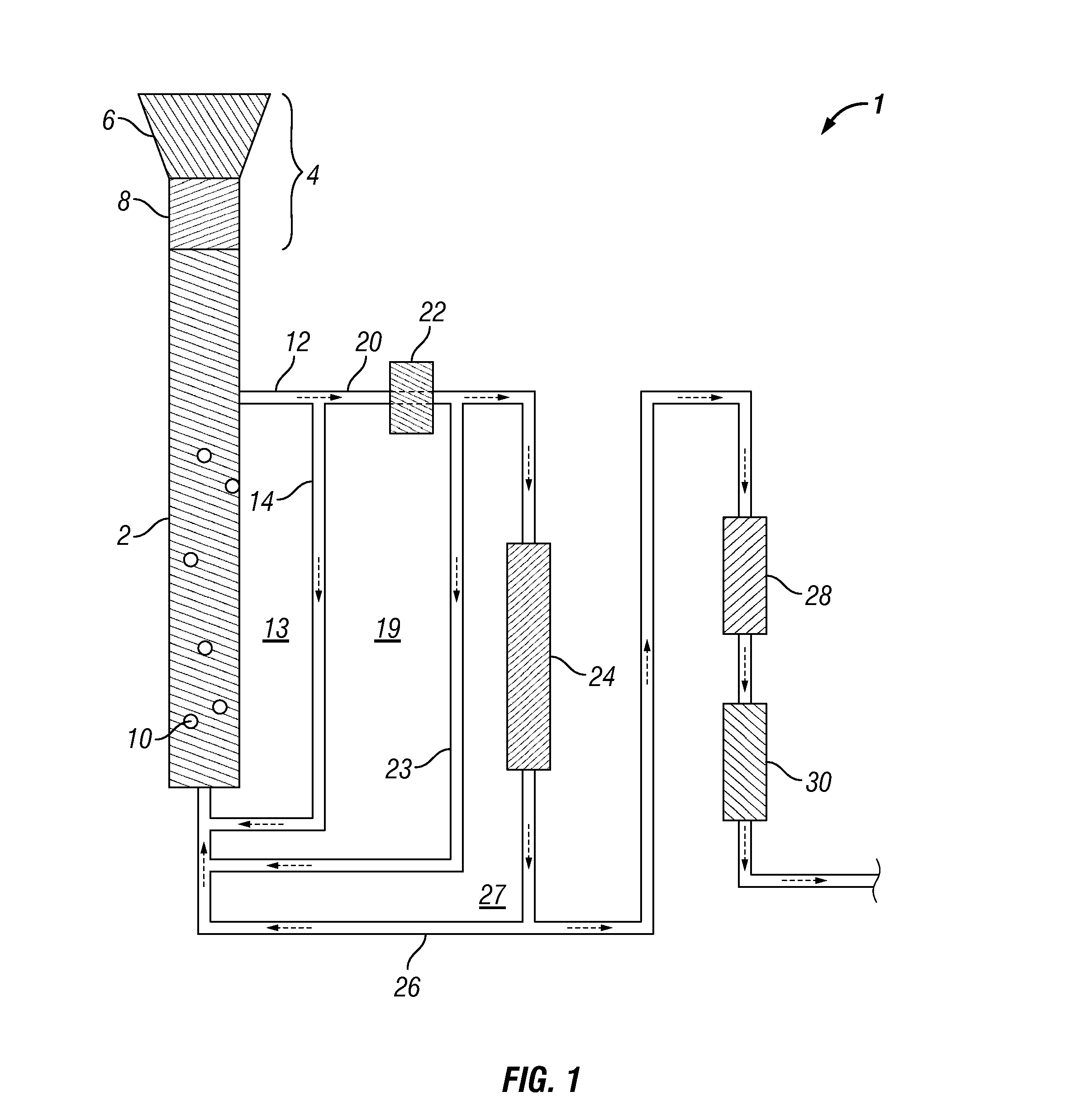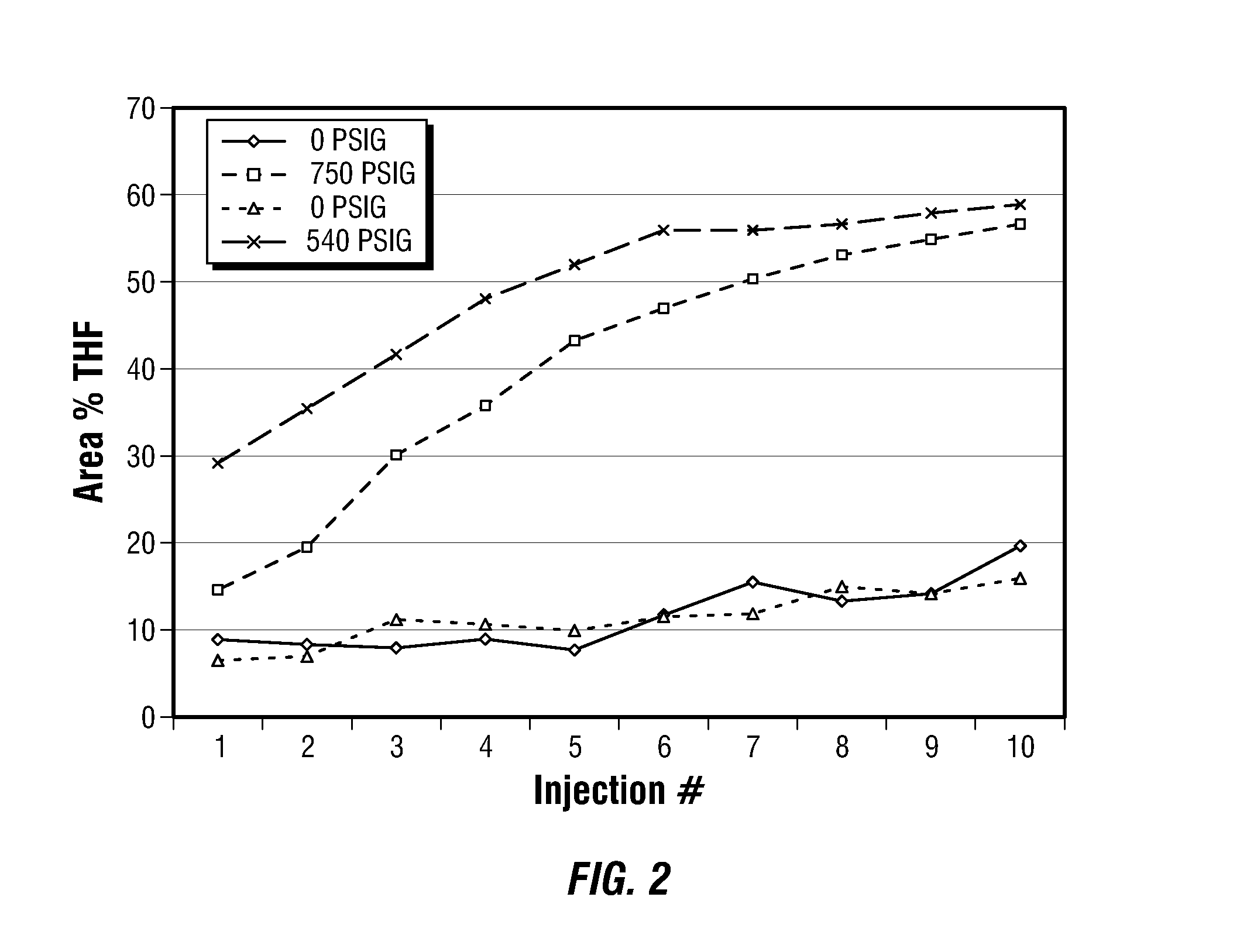Methods for conversion of a glycol reaction product obtained from hydrothermal digestion of cellulosic biomass solids into a dried monohydric alcohol feed
a cellulosic biomass solids and hydrothermal digestion technology, applied in the field of conversion of glycol reaction products obtained in conjunction with hydrothermal digestion of cellulosic biomass solids into monohydric alcohol feed, can solve the problems of low energy density, slow development and implementation of bio-based fuel technology, and difficult processing
- Summary
- Abstract
- Description
- Claims
- Application Information
AI Technical Summary
Benefits of technology
Problems solved by technology
Method used
Image
Examples
example 1
Formation of a Glycol from Cellulosic Biomass Solids in the Presence of Water Digestion Solvent
[0106]A 100 mL Parr reactor was charged with 60.16 mL of deionized water, 0.195 grams of potassium carbonate buffer, and 0.754 grams of nickel-oxide promoted cobalt molybdate catalyst was added (DC-2534, Criterion Catalyst Technologies, L.P., containing 1-10% cobalt oxide and molybdenum trioxide (up to 30 wt %) on alumina, and less than 2% nickel). The catalyst was previously sulfided as described in U.S. Patent Application Publication US2010 / 0236988, which is incorporated herein by reference in its entirety. The reactor was charged with 5.1 grams of southern pine mini-chips (39% moisture) having nominal dimensions of 3 mm×5 mm×5 mm, before pressurizing with 53 bar of hydrogen. The stirred reactor was heated to 190° C. for 1 hour before ramping over 15 minutes to a temperature of 250° C. and holding to complete a 5-hour cycle.
[0107]At the end of a reaction cycle, 5 grams of aqueous product...
example 2
Formation of a Glycol from Cellulosic Biomass Solids in the Presence of a Digestion Solvent Comprising Ethylene Glycol, Propylene Glycol, and Water
[0109]The digestion process of Example 1 was repeated, except the digestion solvent comprised 45% propylene glycol and 5% ethylene glycol in deionized water. In this case, the reaction sequence was repeated over 20 cycles without plugging of the sintered metal filter occurring, thereby showing that greater solubility was achieved in the presence of an organic solvent.
example 3
Drying in the Presence of a Glycol Solvent
[0110]A 75 mL Parr5000 reactor was charged with 18.06 grams of 1,2-propylene glycol, 2.04 grams of ethylene glycol, and 6.74 grams of deionized water to provide a solvent mixture. To this mixture, 0.121 grams of potassium carbonate buffer were added, along with 0.305 grams of the cobalt molybdate catalyst from Example 1. 2.71 grams of soft pine wood minichips were added (39% moisture). The reactor was pressurized to 53 bar with hydrogen and heated to 190° C. for 1 hour, followed by heating to 230° C. for 4 hours.
[0111]After digestion and reaction, the catalyst and undigested wood were separated by vacuum filtration (Whatman GF / F paper). The filtrate was distilled at atmospheric pressure under a blanket of nitrogen, using a short path microdistillation still with 100 mL catch flask. 4.43 grams of distillate were obtained at a 156.1° C. bottoms temperature and a 98.4° C. tops temperature. The distillate contained only 0.13 grams of measured or...
PUM
| Property | Measurement | Unit |
|---|---|---|
| Percent by mass | aaaaa | aaaaa |
| Weight | aaaaa | aaaaa |
| Molecular weight | aaaaa | aaaaa |
Abstract
Description
Claims
Application Information
 Login to View More
Login to View More - R&D
- Intellectual Property
- Life Sciences
- Materials
- Tech Scout
- Unparalleled Data Quality
- Higher Quality Content
- 60% Fewer Hallucinations
Browse by: Latest US Patents, China's latest patents, Technical Efficacy Thesaurus, Application Domain, Technology Topic, Popular Technical Reports.
© 2025 PatSnap. All rights reserved.Legal|Privacy policy|Modern Slavery Act Transparency Statement|Sitemap|About US| Contact US: help@patsnap.com


